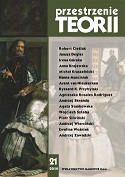Wspólna twarz – Różewicz, Rembrandt i starość
The common face: Różewicz, Rembrandt and old age
Author(s): Agnieszka Rosales RodriguezSubject(s): Language and Literature Studies, Fine Arts / Performing Arts, Visual Arts, Studies of Literature, Polish Literature, Theory of Literature
Published by: Uniwersytet im. Adama Mickiewicza w Poznaniu
Keywords: Różewicz; Rembrandt; mirror; old age; death; Zeuxis;
Summary/Abstract: This article proposes an interpretation of Rembrandt’s Self-Portrait as Zeuxis Laughing (Wallraf- -Richartz Museum, Cologne) as it appears in Tadeusz Różewicz’s poem Mirror. The 17th-century Dutch artist was known as a painter who portrayed the human body as it really is, i.e. with all its imperfections and changes that are brought about by the passage of time. He has also been regarded as a master who expressed the disappearance and decay of form (Simmel) and the anticipation of death (Malraux) by using an unconventional technique. Różewicz “appropriated” Rembrandt’s face to speak of the inevitability of getting old and dying, the limits of Logos and poetry as well as the powerlessness of a poet whose fatal destiny is to describe and testify to suffering. Rembrandt’s figure appears in a flash of light, but at the same time seems to melt into thick paint, to disappear, like the poet’s words on the surface of silence, thus suggestively representing the moment of the subject’s transformation and crossing the border between life and death, the artist’s withdrawal from the world and last breath as well as the limits of literature, i.e. the loss of discourse. In this poetic epiphany, Rembrandt is – let us refer to Harold Bloom’s famous concept of apophrades – the great dead returning in Różewicz’s work.
Journal: Przestrzenie Teorii
- Issue Year: 2014
- Issue No: 21
- Page Range: 167-180
- Page Count: 14
- Language: Polish

